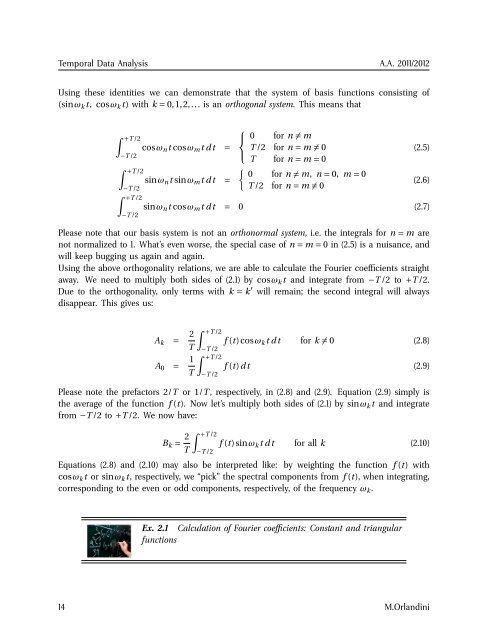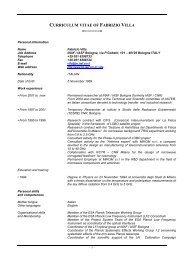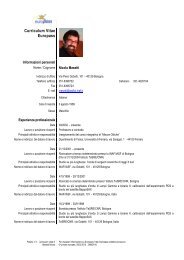booklet format - inaf iasf bologna
booklet format - inaf iasf bologna
booklet format - inaf iasf bologna
Create successful ePaper yourself
Turn your PDF publications into a flip-book with our unique Google optimized e-Paper software.
Temporal Data Analysis A.A. 2011/2012<br />
Using these identities we can demonstrate that the system of basis functions consisting of<br />
(sinω k t, cosω k t) with k = 0,1,2,... is an orthogonal system. This means that<br />
∫ +T /2<br />
−T /2<br />
∫ +T /2<br />
−T /2<br />
∫ +T /2<br />
−T /2<br />
cosω n t cosω m t dt =<br />
sinω n t sinω m t dt =<br />
⎧<br />
⎨<br />
⎩<br />
0 for n ≠ m<br />
T /2 for n = m ≠ 0<br />
T for n = m = 0<br />
{ 0 for n ≠ m, n = 0, m = 0<br />
T /2 for n = m ≠ 0<br />
(2.5)<br />
(2.6)<br />
sinω n t cosω m t dt = 0 (2.7)<br />
Please note that our basis system is not an orthonormal system, i.e. the integrals for n = m are<br />
not normalized to 1. What’s even worse, the special case of n = m = 0 in (2.5) is a nuisance, and<br />
will keep bugging us again and again.<br />
Using the above orthogonality relations, we are able to calculate the Fourier coefficients straight<br />
away. We need to multiply both sides of (2.1) by cosω k t and integrate from −T /2 to +T /2.<br />
Due to the orthogonality, only terms with k = k ′ will remain; the second integral will always<br />
disappear. This gives us:<br />
A k = 2 T<br />
A 0 = 1 T<br />
∫ +T /2<br />
−T /2<br />
∫ +T /2<br />
−T /2<br />
f (t)cosω k t dt for k ≠ 0 (2.8)<br />
f (t)dt (2.9)<br />
Please note the prefactors 2/T or 1/T , respectively, in (2.8) and (2.9). Equation (2.9) simply is<br />
the average of the function f (t). Now let’s multiply both sides of (2.1) by sinω k t and integrate<br />
from −T /2 to +T /2. We now have:<br />
B k = 2 T<br />
∫ +T /2<br />
−T /2<br />
f (t)sinω k t dt for all k (2.10)<br />
Equations (2.8) and (2.10) may also be interpreted like: by weighting the function f (t) with<br />
cosω k t or sinω k t, respectively, we “pick” the spectral components from f (t), when integrating,<br />
corresponding to the even or odd components, respectively, of the frequency ω k .<br />
Ex. 2.1 Calculation of Fourier coefficients: Constant and triangular<br />
functions<br />
14 M.Orlandini

















